An In-Depth Analysis of Intel's Technology and Operations
VerifiedAdded on 2020/04/15
|6
|1128
|227
Report
AI Summary
This report provides a comprehensive analysis of Intel Corporation's technology and operations. It begins with an introduction to Intel, highlighting its position as a leading multinational technology company and a major manufacturer of microprocessors. The report then delves into an industry analysis using Porter's five forces model, assessing the threats of new entrants, the bargaining power of suppliers and buyers, the threat of substitute products, and the competitive rivalry within the industry. The analysis reveals the competitive pressures Intel faces. The report then examines Intel's product differentiation and specialization strategies, focusing on its diverse product portfolio, including processors, chipsets, and server products. It discusses the importance of differentiating products to avoid price wars and the need to focus on specific consumer groups and emerging markets, such as mobile internet devices. The conclusion summarizes the key findings, emphasizing Intel's position in the semiconductor industry and the significance of its technological advancements and strategic adaptations to maintain its competitive edge.
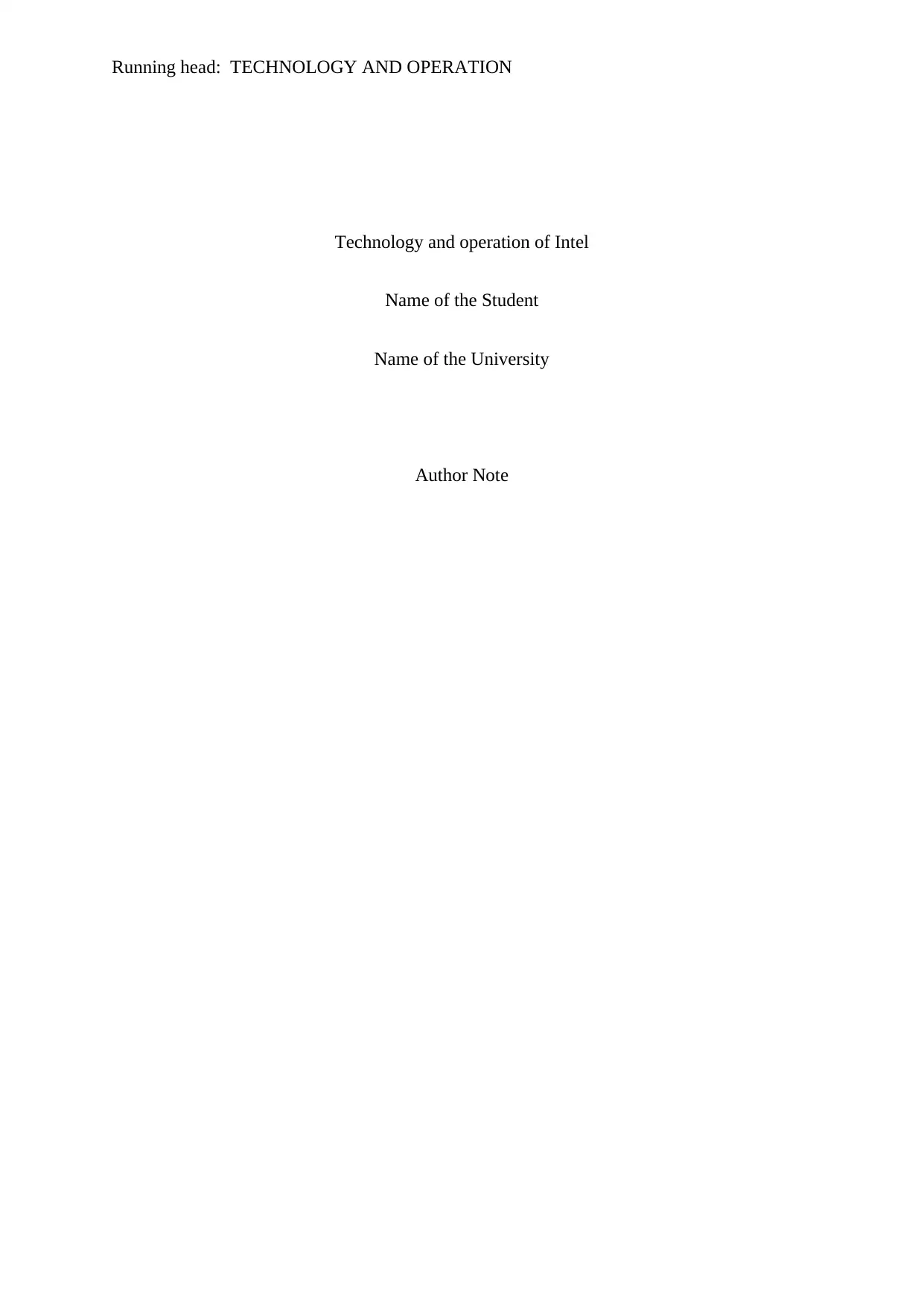
Running head: TECHNOLOGY AND OPERATION
Technology and operation of Intel
Name of the Student
Name of the University
Author Note
Technology and operation of Intel
Name of the Student
Name of the University
Author Note
Paraphrase This Document
Need a fresh take? Get an instant paraphrase of this document with our AI Paraphraser
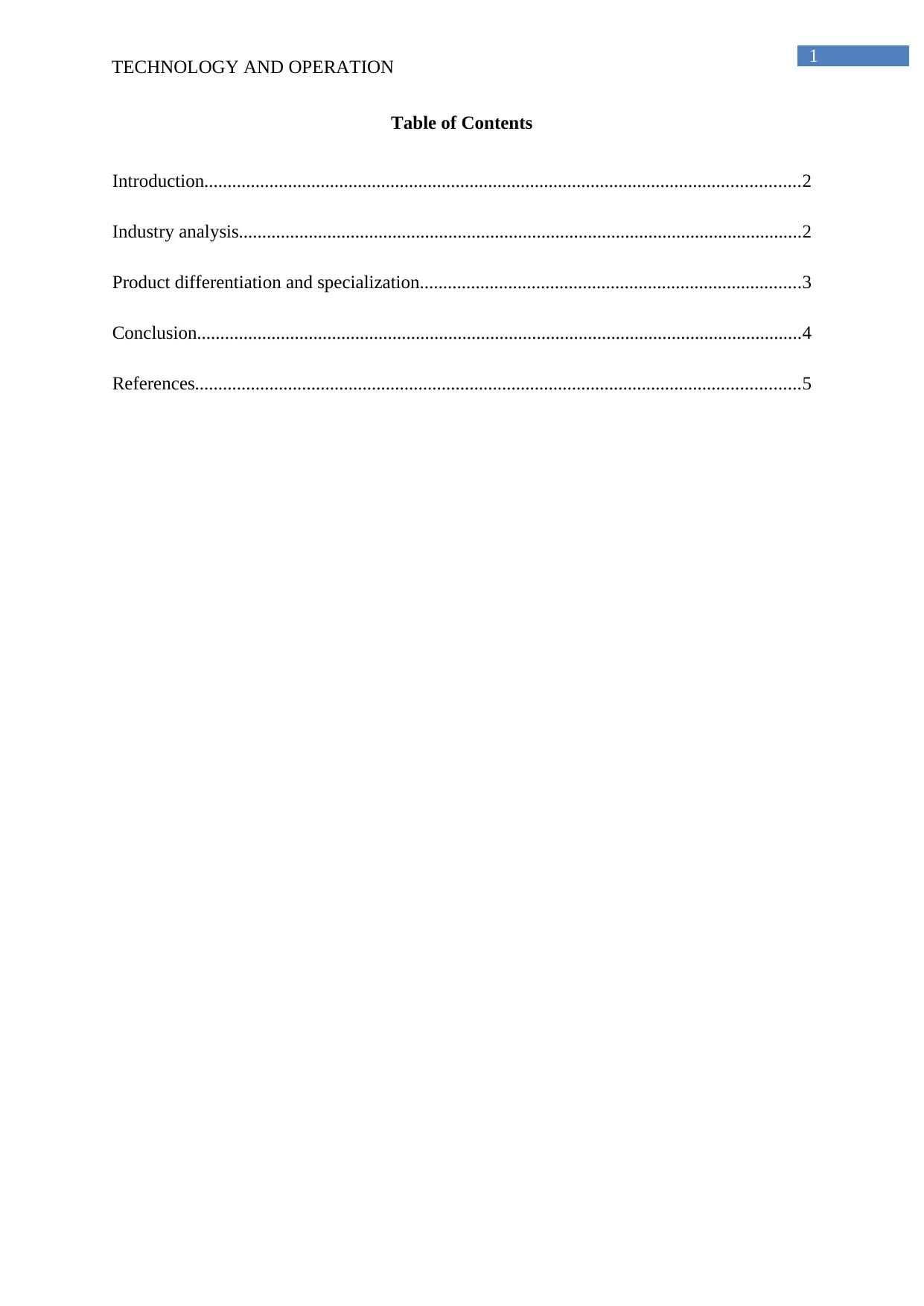
1
TECHNOLOGY AND OPERATION
Table of Contents
Introduction................................................................................................................................2
Industry analysis.........................................................................................................................2
Product differentiation and specialization..................................................................................3
Conclusion..................................................................................................................................4
References..................................................................................................................................5
TECHNOLOGY AND OPERATION
Table of Contents
Introduction................................................................................................................................2
Industry analysis.........................................................................................................................2
Product differentiation and specialization..................................................................................3
Conclusion..................................................................................................................................4
References..................................................................................................................................5
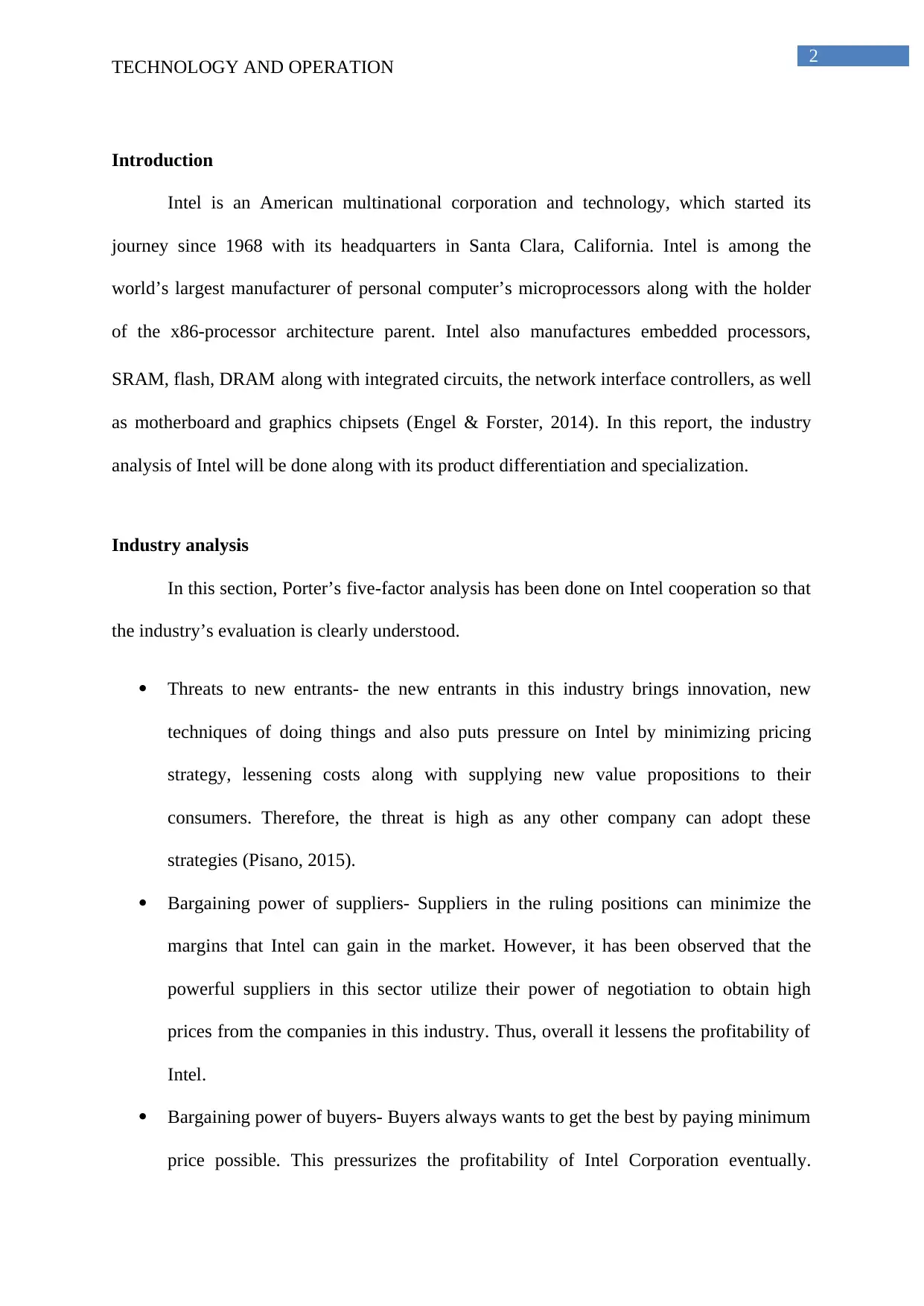
2
TECHNOLOGY AND OPERATION
Introduction
Intel is an American multinational corporation and technology, which started its
journey since 1968 with its headquarters in Santa Clara, California. Intel is among the
world’s largest manufacturer of personal computer’s microprocessors along with the holder
of the x86-processor architecture parent. Intel also manufactures embedded processors,
SRAM, flash, DRAM along with integrated circuits, the network interface controllers, as well
as motherboard and graphics chipsets (Engel & Forster, 2014). In this report, the industry
analysis of Intel will be done along with its product differentiation and specialization.
Industry analysis
In this section, Porter’s five-factor analysis has been done on Intel cooperation so that
the industry’s evaluation is clearly understood.
Threats to new entrants- the new entrants in this industry brings innovation, new
techniques of doing things and also puts pressure on Intel by minimizing pricing
strategy, lessening costs along with supplying new value propositions to their
consumers. Therefore, the threat is high as any other company can adopt these
strategies (Pisano, 2015).
Bargaining power of suppliers- Suppliers in the ruling positions can minimize the
margins that Intel can gain in the market. However, it has been observed that the
powerful suppliers in this sector utilize their power of negotiation to obtain high
prices from the companies in this industry. Thus, overall it lessens the profitability of
Intel.
Bargaining power of buyers- Buyers always wants to get the best by paying minimum
price possible. This pressurizes the profitability of Intel Corporation eventually.
TECHNOLOGY AND OPERATION
Introduction
Intel is an American multinational corporation and technology, which started its
journey since 1968 with its headquarters in Santa Clara, California. Intel is among the
world’s largest manufacturer of personal computer’s microprocessors along with the holder
of the x86-processor architecture parent. Intel also manufactures embedded processors,
SRAM, flash, DRAM along with integrated circuits, the network interface controllers, as well
as motherboard and graphics chipsets (Engel & Forster, 2014). In this report, the industry
analysis of Intel will be done along with its product differentiation and specialization.
Industry analysis
In this section, Porter’s five-factor analysis has been done on Intel cooperation so that
the industry’s evaluation is clearly understood.
Threats to new entrants- the new entrants in this industry brings innovation, new
techniques of doing things and also puts pressure on Intel by minimizing pricing
strategy, lessening costs along with supplying new value propositions to their
consumers. Therefore, the threat is high as any other company can adopt these
strategies (Pisano, 2015).
Bargaining power of suppliers- Suppliers in the ruling positions can minimize the
margins that Intel can gain in the market. However, it has been observed that the
powerful suppliers in this sector utilize their power of negotiation to obtain high
prices from the companies in this industry. Thus, overall it lessens the profitability of
Intel.
Bargaining power of buyers- Buyers always wants to get the best by paying minimum
price possible. This pressurizes the profitability of Intel Corporation eventually.
⊘ This is a preview!⊘
Do you want full access?
Subscribe today to unlock all pages.

Trusted by 1+ million students worldwide

3
TECHNOLOGY AND OPERATION
However, smaller and stronger customer base of Intel Corporation increases the
bargaining power of the consumers, which in turn increases the ability of the
consumers to seek for higher discounts and offers (Akhter, Rahman & Rahman,
2014).
Threats of substitute products or services- For Intel this threat increases when it
provides a value proposition, which is solely different, the present offerings in the
industry. For instance, Dropbox and Google Drive are the replacements to storage
hardware drives and thus, can be threatening to Intel.
Rivalry among the existing competitors- Intel Corporation functions in very
competitive industry. However, this competition does harm the comprehensive long-
term profitability of Intel. It has already defeated all other microprocessor developers
like Cyrix and NexGen, now Intel’s real competitors are from the developers of
Athlon, Thunderbird and the CPUs of Sledgehammer. Moreover, from the
Microprocessor SBU viewpoint there will be only one competitor who will stay in the
end: Advanced Micro Devices (Nihoul, 2014).
Product differentiation and specialization
The current products that Intel sells are Devices & Systems, Processors, Solid State
Drives, Chipsets, Boards & Kits, and Server Products, networking & Communications,
Wireless, Software & Services, Intel Gateways and FPGAs. However, AMD is very much
capable of following or improvising on maximum of the technologies given by Intel.
Therefore, without the existence of such technological obstructions, competition often
degenerate into price wars which in turn causes both the organizations to lose their profits?
However, Intel can avoid these expensive price wars if they differentiate their products
towards the particular orientations of the consumers. Moreover, it can be manifested by
TECHNOLOGY AND OPERATION
However, smaller and stronger customer base of Intel Corporation increases the
bargaining power of the consumers, which in turn increases the ability of the
consumers to seek for higher discounts and offers (Akhter, Rahman & Rahman,
2014).
Threats of substitute products or services- For Intel this threat increases when it
provides a value proposition, which is solely different, the present offerings in the
industry. For instance, Dropbox and Google Drive are the replacements to storage
hardware drives and thus, can be threatening to Intel.
Rivalry among the existing competitors- Intel Corporation functions in very
competitive industry. However, this competition does harm the comprehensive long-
term profitability of Intel. It has already defeated all other microprocessor developers
like Cyrix and NexGen, now Intel’s real competitors are from the developers of
Athlon, Thunderbird and the CPUs of Sledgehammer. Moreover, from the
Microprocessor SBU viewpoint there will be only one competitor who will stay in the
end: Advanced Micro Devices (Nihoul, 2014).
Product differentiation and specialization
The current products that Intel sells are Devices & Systems, Processors, Solid State
Drives, Chipsets, Boards & Kits, and Server Products, networking & Communications,
Wireless, Software & Services, Intel Gateways and FPGAs. However, AMD is very much
capable of following or improvising on maximum of the technologies given by Intel.
Therefore, without the existence of such technological obstructions, competition often
degenerate into price wars which in turn causes both the organizations to lose their profits?
However, Intel can avoid these expensive price wars if they differentiate their products
towards the particular orientations of the consumers. Moreover, it can be manifested by
Paraphrase This Document
Need a fresh take? Get an instant paraphrase of this document with our AI Paraphraser
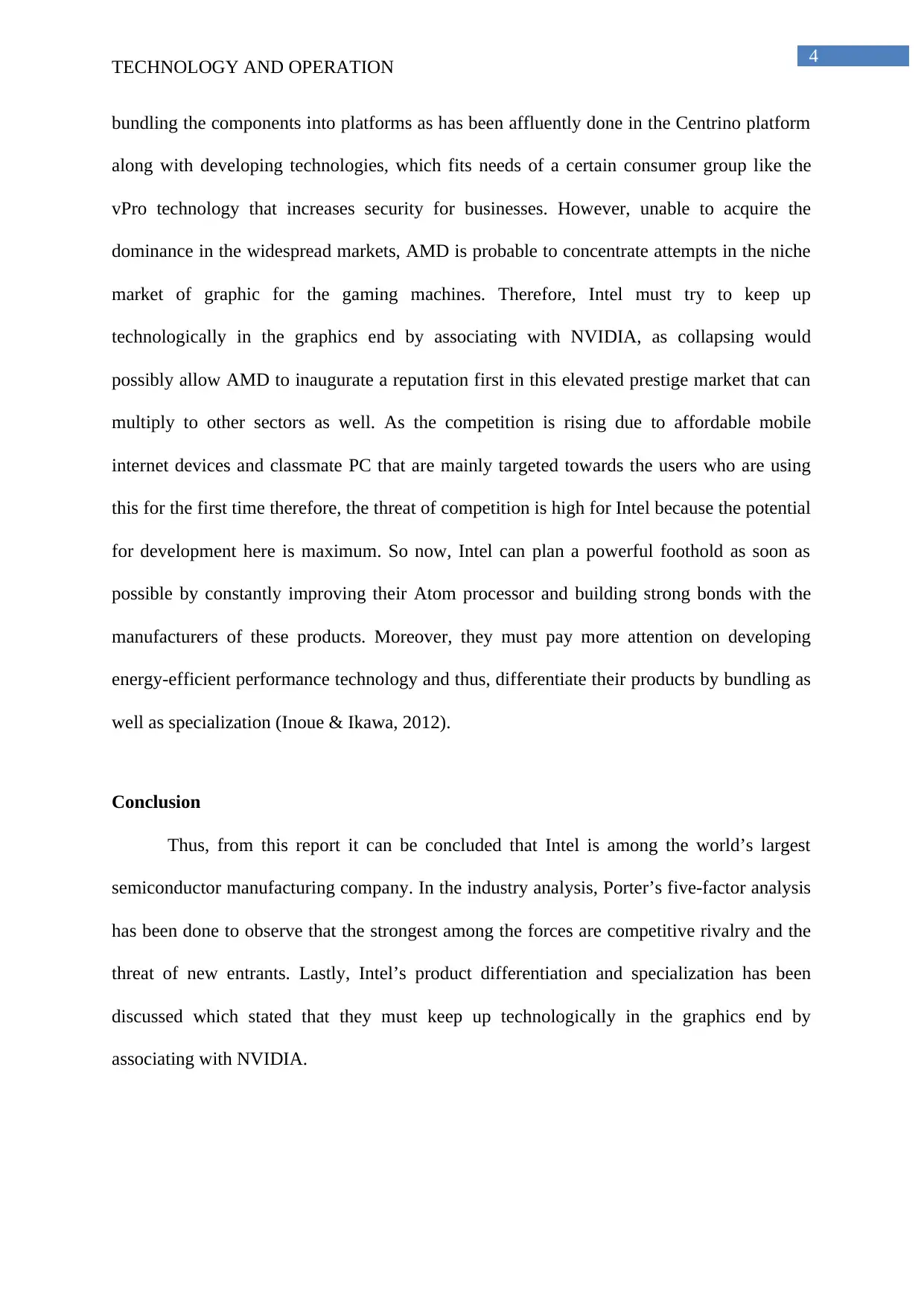
4
TECHNOLOGY AND OPERATION
bundling the components into platforms as has been affluently done in the Centrino platform
along with developing technologies, which fits needs of a certain consumer group like the
vPro technology that increases security for businesses. However, unable to acquire the
dominance in the widespread markets, AMD is probable to concentrate attempts in the niche
market of graphic for the gaming machines. Therefore, Intel must try to keep up
technologically in the graphics end by associating with NVIDIA, as collapsing would
possibly allow AMD to inaugurate a reputation first in this elevated prestige market that can
multiply to other sectors as well. As the competition is rising due to affordable mobile
internet devices and classmate PC that are mainly targeted towards the users who are using
this for the first time therefore, the threat of competition is high for Intel because the potential
for development here is maximum. So now, Intel can plan a powerful foothold as soon as
possible by constantly improving their Atom processor and building strong bonds with the
manufacturers of these products. Moreover, they must pay more attention on developing
energy-efficient performance technology and thus, differentiate their products by bundling as
well as specialization (Inoue & Ikawa, 2012).
Conclusion
Thus, from this report it can be concluded that Intel is among the world’s largest
semiconductor manufacturing company. In the industry analysis, Porter’s five-factor analysis
has been done to observe that the strongest among the forces are competitive rivalry and the
threat of new entrants. Lastly, Intel’s product differentiation and specialization has been
discussed which stated that they must keep up technologically in the graphics end by
associating with NVIDIA.
TECHNOLOGY AND OPERATION
bundling the components into platforms as has been affluently done in the Centrino platform
along with developing technologies, which fits needs of a certain consumer group like the
vPro technology that increases security for businesses. However, unable to acquire the
dominance in the widespread markets, AMD is probable to concentrate attempts in the niche
market of graphic for the gaming machines. Therefore, Intel must try to keep up
technologically in the graphics end by associating with NVIDIA, as collapsing would
possibly allow AMD to inaugurate a reputation first in this elevated prestige market that can
multiply to other sectors as well. As the competition is rising due to affordable mobile
internet devices and classmate PC that are mainly targeted towards the users who are using
this for the first time therefore, the threat of competition is high for Intel because the potential
for development here is maximum. So now, Intel can plan a powerful foothold as soon as
possible by constantly improving their Atom processor and building strong bonds with the
manufacturers of these products. Moreover, they must pay more attention on developing
energy-efficient performance technology and thus, differentiate their products by bundling as
well as specialization (Inoue & Ikawa, 2012).
Conclusion
Thus, from this report it can be concluded that Intel is among the world’s largest
semiconductor manufacturing company. In the industry analysis, Porter’s five-factor analysis
has been done to observe that the strongest among the forces are competitive rivalry and the
threat of new entrants. Lastly, Intel’s product differentiation and specialization has been
discussed which stated that they must keep up technologically in the graphics end by
associating with NVIDIA.
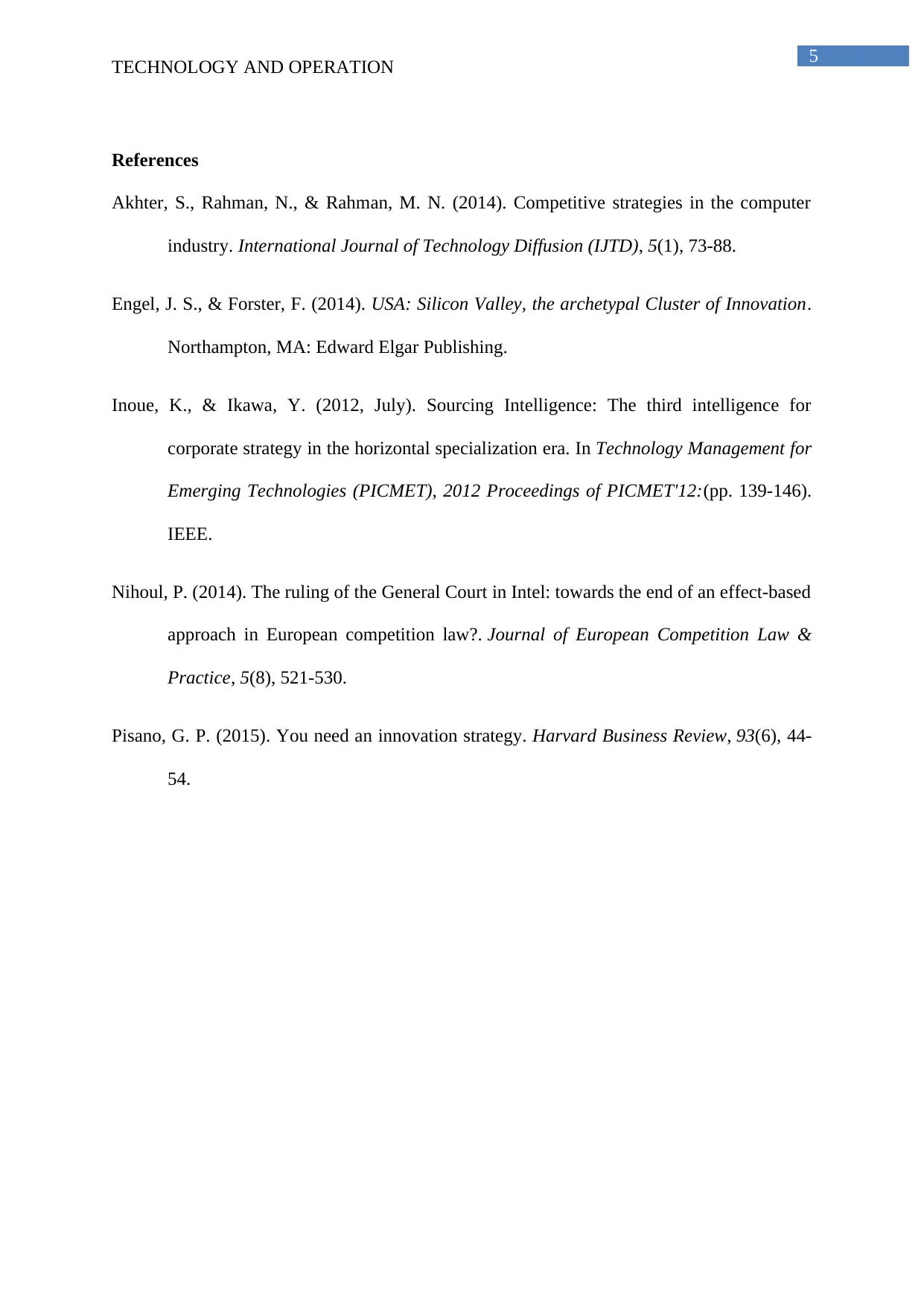
5
TECHNOLOGY AND OPERATION
References
Akhter, S., Rahman, N., & Rahman, M. N. (2014). Competitive strategies in the computer
industry. International Journal of Technology Diffusion (IJTD), 5(1), 73-88.
Engel, J. S., & Forster, F. (2014). USA: Silicon Valley, the archetypal Cluster of Innovation.
Northampton, MA: Edward Elgar Publishing.
Inoue, K., & Ikawa, Y. (2012, July). Sourcing Intelligence: The third intelligence for
corporate strategy in the horizontal specialization era. In Technology Management for
Emerging Technologies (PICMET), 2012 Proceedings of PICMET'12:(pp. 139-146).
IEEE.
Nihoul, P. (2014). The ruling of the General Court in Intel: towards the end of an effect-based
approach in European competition law?. Journal of European Competition Law &
Practice, 5(8), 521-530.
Pisano, G. P. (2015). You need an innovation strategy. Harvard Business Review, 93(6), 44-
54.
TECHNOLOGY AND OPERATION
References
Akhter, S., Rahman, N., & Rahman, M. N. (2014). Competitive strategies in the computer
industry. International Journal of Technology Diffusion (IJTD), 5(1), 73-88.
Engel, J. S., & Forster, F. (2014). USA: Silicon Valley, the archetypal Cluster of Innovation.
Northampton, MA: Edward Elgar Publishing.
Inoue, K., & Ikawa, Y. (2012, July). Sourcing Intelligence: The third intelligence for
corporate strategy in the horizontal specialization era. In Technology Management for
Emerging Technologies (PICMET), 2012 Proceedings of PICMET'12:(pp. 139-146).
IEEE.
Nihoul, P. (2014). The ruling of the General Court in Intel: towards the end of an effect-based
approach in European competition law?. Journal of European Competition Law &
Practice, 5(8), 521-530.
Pisano, G. P. (2015). You need an innovation strategy. Harvard Business Review, 93(6), 44-
54.
⊘ This is a preview!⊘
Do you want full access?
Subscribe today to unlock all pages.

Trusted by 1+ million students worldwide
1 out of 6
Related Documents
Your All-in-One AI-Powered Toolkit for Academic Success.
+13062052269
info@desklib.com
Available 24*7 on WhatsApp / Email
![[object Object]](/_next/static/media/star-bottom.7253800d.svg)
Unlock your academic potential
Copyright © 2020–2025 A2Z Services. All Rights Reserved. Developed and managed by ZUCOL.





